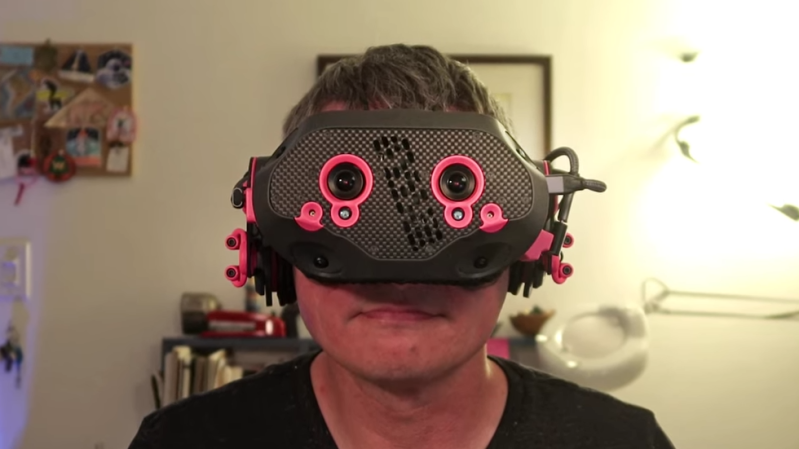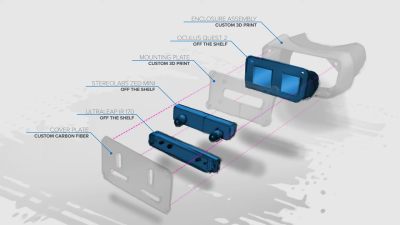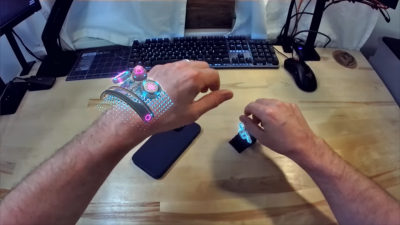[PyottDesign] recently wrapped up a personal project to create himself a custom AR/VR headset that could function as an AR (augmented reality) platform, and make it easier to develop new applications in a headset that could do everything he needed. He succeeded wonderfully, and published a video showcase of the finished project.
Getting a headset with the features he wanted wasn’t possible by buying off the shelf, so he accomplished his goals with a skillful custom repackaging of a Quest 2 VR headset, integrating a Stereolabs Zed Mini stereo camera (aimed at mixed reality applications) and an Ultraleap IR 170 hand tracking module. These hardware modules have tons of software support and are not very big, but when sticking something onto a human face, every millimeter and gram counts.
[PyottDesign]’s work reveals quite a few nice build details. He 3D scanned his face in order to create parts with a custom fit and made great use of 3D printing, even dyeing parts as needed. Other structural components were cut from thin carbon fiber inlay sheets, which provided great strength with very little mass.
The end result does require three separate USB cables (one for each of the main hardware components) so a possible improvement would be to integrate some kind of hub, but for now [PyottDesign] is just going to enjoy the fruits of his labors. The video showcasing the end result (embedded below, under the page break) gives a summary of the build process, but if you’d like to delve into aspects of the project in more detail, check out the 10-video series covering everything from concept to finished unit.
Speaking of DIY VR headsets, we recently saw another custom headset build that took a much more ground-up approach, but also serves as a reminder of just how much work goes into building something like this. Like they say, developing hardware is just like software, except every time you hit “compile” it costs money and takes weeks.

















Can´t wait to see all commuters fitted with such a thing (and some cheap versions with ads). A bright future for dehumanity !
Lol you think you’ll be seeing people outside!
Obviously not, google AI will filter people out in real time by then. You’ll never need to interact with another person again.
As an early adopter of VR, the tech is getting there. Currently stalled for new breakthroughs. AR devices are like HoloLens, with a clear display over your eyes, and it only adds things to appear over your own clear, real vision. Military has been using this for years, for example, especially with helicopter visors. MR hasn’t reached a good level yet really. The Quest 2/Quest Pro/Quest 3 are the most popular standalone devices but they are still customized cell phones. When I connect to my computer, my 3080 FTW3 Ultra does a pretty good job of rendering. But it will be a while before we have portable tech that can handle the processing of not only 3d environment, but real time processing of your movements at a high refresh rate. MR will require top quality cameras that don’t distort when you move around. Also have to take into account battery life. No one wants to wear a battery on their back or hip. They are working on some VR SoCs, which will be necessary. Hand tracking is still a ways off from being immersive because if the back of your hand is aimed at your face, the cameras can’t see the other side of your hand. Controller tech is decent but the Quest Pro controllers which have their own cameras, still have tracking issues but they work even when out of view of the headset. With displays so close to your face, high pixel density is needed to not notice the screen door effect. It’s getting better. Pancake lenses still sometimes produce god rays.
Don’t suggest the idea of ads at all. We have been lucky enough to not be invaded by them yet. Meta tried it in one product and it was immediately rejected. Once theres an acceptance of it, it will never go away, like the web now.
As an early adopter of VR, the tech is getting there. Currently stalled for new breakthroughs. AR devices are like HoloLens, with a clear display over your eyes, and it only adds things to appear over your own clear, real vision. Military has been using this for years, for example, especially with helicopter visors. MR hasn’t reached a good level yet really. The Quest 2/Quest Pro/Quest 3 are the most popular standalone devices but they are still customized cell phones. When I connect to my computer, my 3080 FTW3 Ultra does a pretty good job of rendering. But it will be a while before we have portable tech that can handle the processing of not only 3d environment, but real time processing of your movements at a high refresh rate. MR will require top quality cameras that don’t distort when you move around. Also have to take into account battery life. No one wants to wear a battery on their back or hip. They are working on some VR SoCs, which will be necessary. Hand tracking is still a ways off from being immersive because if the back of your hand is aimed at your face, the cameras can’t see the other side of your hand. Controller tech is decent but the Quest Pro controllers which have their own cameras, still have tracking issues but they work even when out of view of the headset. With displays so close to your face, high pixel density is needed to not notice the screen door effect. It’s getting better. Pancake lenses still sometimes produce god rays.
Don’t suggest the idea of ads at all. We have been lucky enough to not be invaded by them yet. Meta tried it in one product and it was immediately rejected. Once theres an acceptance of it, it will never go away, like the web now.
that you’re obsessed with dystopia is a mirror to what you are inside. embrace utopia.
EDIT:Does HAD let authors edit? or do just hit submit and get stuck with your mistakes?
MR=VR+cameras. NOT AR as I mistyped previously.
>MR=MIXED REALITY This is when your VR headset has cameras to allow you to see the real world too.
Might want to brush up on keyboards before submitting a comment next time.
The amount for work, and the quality of the build, is impressive! Thanks for sharing it.
I thought the Quest 2 already supported hand tracking using its built-in cameras
Whoops. Meant to reply to OP
It does, but it can only see things through IR cameras, so it is limited in actual AR renditions. And I have not seen any live feed overlays that were not experimental.